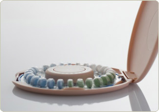|
Birth Control Options for Women with Spinal Cord Injury
by Stanley
Ducharme, Ph.D.
 There are a range of issues for women with spinal cord injury (SCI) who are considering the use of birth control. Unfortunately however, there are not a lot of resources with up to date information for women weighing these decisions. This brief article provides an overview of some of the currently available birth control options. After reviewing some of these choices, it's a good idea for women with SCI to have a conversation with their health care provider as to what's best for you. There are a range of issues for women with spinal cord injury (SCI) who are considering the use of birth control. Unfortunately however, there are not a lot of resources with up to date information for women weighing these decisions. This brief article provides an overview of some of the currently available birth control options. After reviewing some of these choices, it's a good idea for women with SCI to have a conversation with their health care provider as to what's best for you.
Hormonal IUD: The hormonal IUD is a small T shaped devise that is inserted and removed by a trained physician. It stays in the uterus for up to 5 years. It releases a small amount of hormone each day which causes the cervical mucus to thicken. This acts as a barrier to prevent sperm from entering the uterus. Although it may cause some irregular bleeding for a few months the benefits are that it is inserted by a physician and does not require insertion by the women with SCI or her partner. The down side is that some women have a reaction to the hormone and with decreased sensation there is the danger of a perforation (A small tear) that may go unnoticed. Infection may also be an issue since this may be difficult to detect due to diminished sensation.
Copper IUD: The copper IUD is inserted and removed by a physician and can last for up to 10 years. It stops the sperm from reaching and fertilizing the egg. It is reported to be effective in 99% of women. The benefits are that the woman has up to 10 years of protection and it is inserted and removed by the physician. This IUD is sometimes used as an "emergency birth control". The doctor can insert a Copper IUD up to 5 days after intercourse to prevent a fertilized egg from implanting in the uterus.
With this form of birth control, there is no need to remember to take a pill and it does not require any fine motor dexterity by the woman or her partner. For women with decreased sensation, there is the danger of a perforation which may go unnoticed by the woman. In rare cases, there may be some degree of infection that develops from the IUD. Again, this may be difficult for the woman with SCI to monitor due to her decreased sensation.
The diaphragm: This is a barrier method of birth control that is usually inserted into the vagina by the woman just before having intercourse. Usually, some form of spermicide gel is placed on the diaphragm before it is inserted. Since both squeezing the tube of gel and inserting the diaphragm require some degree of manual dexterity this is usually not a choice for women with SCI. Occasionally, in longer term relationships, the devise is inserted and removed by the partner. Usually however, this is not an option unless the other choices have been ruled out.
The Implant: The implant is a small rod, about the size of a matchstick, that is inserted under the skin by a physician. Usually, it is implanted in the upper arm and is good for up to 3 years. The down side is that there is no protection against STDs and it can cause irregular bleeding for some women. Occasionally, it can affect a woman's mood and sex drive. Typically, it might be a good choice for a woman with SCI since it can be inserted by a doctor and forgot about. It's effective about 99% of the time.
 The Pill: The birth control pill is a combination of hormones that are taken orally. Like other hormonal methods, the pill suppresses ovulation, thickens cervical mucus and thins the lining of the uterus to help block sperm. The down side is that women must remember to take the pill for three weeks each month. It's best if the pill can be taken at the same time each day. If done properly the birth control pill is about 91% effective. The Pill: The birth control pill is a combination of hormones that are taken orally. Like other hormonal methods, the pill suppresses ovulation, thickens cervical mucus and thins the lining of the uterus to help block sperm. The down side is that women must remember to take the pill for three weeks each month. It's best if the pill can be taken at the same time each day. If done properly the birth control pill is about 91% effective.
The pill can cause nausea, headaches, breast tenderness and spotting between periods. Some doctors are concerned about giving the pill to women with SCI because of the dangers of developing deep vein thrombosis (blood clots) in the legs. Some people feel that there is less of a danger of blood clots with some of the newer pills that are currently on the market. Other doctors feel that Progestin only pills are safer for women with SCI. If you are considering a hormone form of birth control, you definitely need to speak with your doctor about your medical history.
The Patch: This is a small patch that you place on your upper arm, shoulder, abdomen, hip or upper back. It delivers a combination of hormones that does the same thing as the birth control pill. It suppresses ovulation and blocks the sperm. On the plus side, you don't need to remember to take a pill on a daily basis but you do need to change the patch on a weekly basis. It has many of the same side effects as the pill and may cause some redness where the patch is applied. For this reason, the location of the patch can be changed to prevent irritation. Again because of possible blood clots, there are some concerns about the safety of the patch for women who have a SCI.
Vaginal Ring: This is a small plastic ring that is inserted into the vagina, which slowly releases hormones into the body. Beside the hormone issue, proper insertion of the ring may be a source of anxiety. Typically, the ring is inserted by the woman or her partner which may be difficult for the woman with SCI. Manual dexterity is required. If the woman is not in a long term relationship, it may be awkward to ask the partner for assistance.
 Condoms: The condom is a barrier method and is presently the only form of male contraception. Female condoms may be an option however they can be difficult to insert and possibly difficult to fit due to possible atrophy in the muscles of the vagina for women with SCI. Condoms may limit spontaneity since they are used just prior to intercourse. On the plus side, they do reduce the risk of STDs and have few side effects unless the person is allergic to latex. Many women with SCI prefer male condoms as a birth control option since the man can take charge of rolling the condom over the penis at the appropriate time. Condoms: The condom is a barrier method and is presently the only form of male contraception. Female condoms may be an option however they can be difficult to insert and possibly difficult to fit due to possible atrophy in the muscles of the vagina for women with SCI. Condoms may limit spontaneity since they are used just prior to intercourse. On the plus side, they do reduce the risk of STDs and have few side effects unless the person is allergic to latex. Many women with SCI prefer male condoms as a birth control option since the man can take charge of rolling the condom over the penis at the appropriate time.
In conclusion, the main birth control considerations for women with SCI are issues regarding manual dexterity, diminished sensation and the side effects of hormones. Most women with SCI prefer an option that does not require insertion each time the woman has sexual intercourse.
It is important to remember that unless a woman wants to have a child, some form of birth control is necessary for women with SCI who are in the childbirth years. After the first few months post injury, spinal cord injury does not prevent pregnancy in any way.
Back
to Articles |

